Sustainable Home Décor Market Research, 2031
The global sustainable home decor market Size was valued at $331.0 billion in 2021, and is projected to reach $556.3 billion by 2031, growing at a CAGR of 5.5% from 2022 to 2031.
The art of creating both aesthetically pleasing interior and exterior spaces that are also practical for occupants is known as sustainable home decor. The sustainable home decor items range from furniture to floor coverings like tiles, wood & laminate, vinyl & rubber, carpets & rugs, and others. They also include home textiles like rugs, bath textiles, bed textiles, kitchen & dining textiles, and living room textiles. Through machine-based and handcrafted procedures, furniture designs can be altered. In developed nations like the U.S., Canada, and Germany, the use of sustainable home decor products is quite widespread, but in rising nations like China, Brazil, and India, consumer demand is expected to grow steadily.
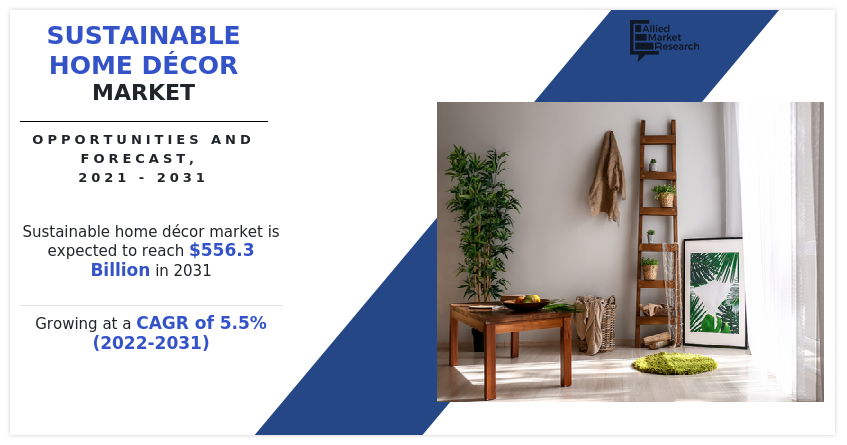
Due to an increase in the population of affluent people, the global market for sustainable home decor has been expanding in emerging economies. Additionally, customers' demand for eco-friendly, sustainable home decor products has changed as a result of increased environmental consciousness, which is a major driving force behind market expansion worldwide. Additionally, rising consumer disposable income in developed and emerging markets drives market expansion. In addition, intensive marketing campaigns and celebrity endorsements have made a big difference in the expansion of the global market. However, the availability of low-quality and counterfeit goods as well as variations in the cost of the raw materials used to make these products limit market expansion.
The global sustainable home decor market is segmented into product type, price point, income group, distribution channel, and region. On the basis of product type, the market is divided into furniture, home textile, and floor covering. As per price point, it is categorized into mass and premium. By income group, it is fragmented into lower-middle income, upper-middle income, and higher income. Depending on distribution channel, it is segregated into supermarkets and hypermarkets, specialty stores, e- commerce, and others. Region wise, the market is analyzed across North America, Europe, Asia-Pacific, and LAMEA.
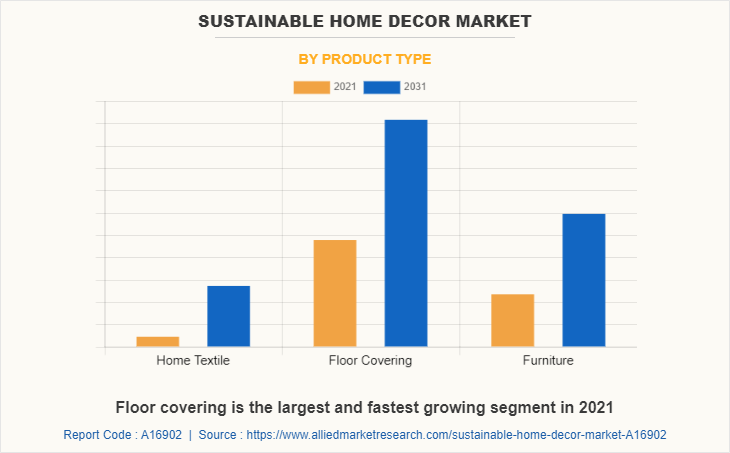
The floor covering segment dominates the global sustainable home decor market. The growth of the tile market has been aided by an increase in urbanization, an increase in disposable income, and an improvement in lifestyle. Additionally, a rise in consumer interest in home décor products has added to the market's expansion.
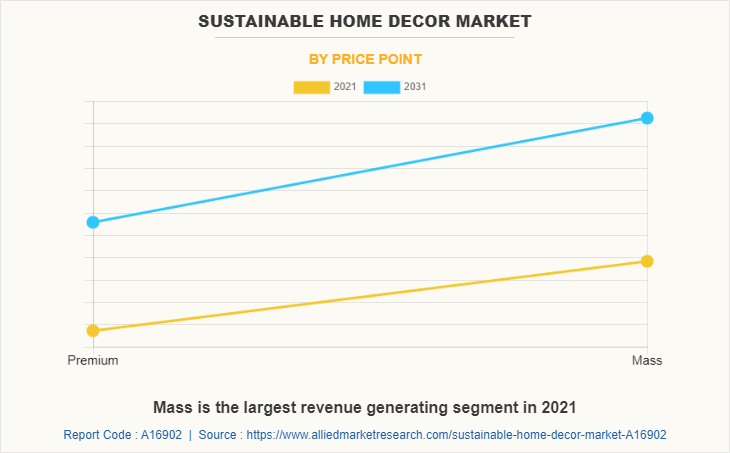
The mass segment dominates the global sustainable home decor market. Increase in consumption of mass pricing products by lower middle and upper middle class consumers significantly contributes toward the sustainable home decor market growth.
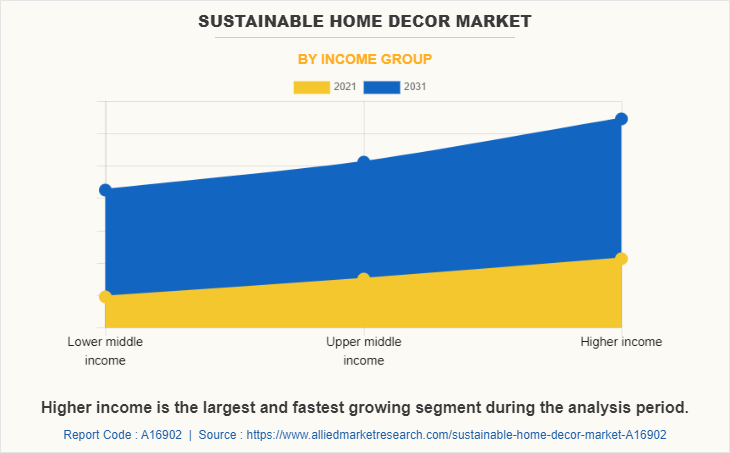
The higher income segment exhibits the fastest growth in the global sustainable home decor market. The high income group of consumers are prone to impulsive buying, which is a key driver of the market.
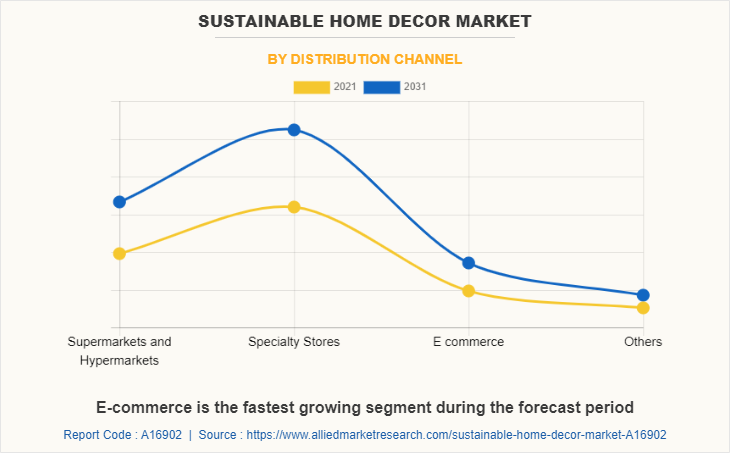
The specialty stores were the most significant segment, accounting for the highest sustainable home decor market share in 2021, according to the projection for the global market for sustainable home decor. However, due to increased internet usage and rising smartphone use for online shopping, the e-commerce segment is anticipated to experience the highest growth over the course of the sustainable home decor market forecast period. This is because these factors enable consumers to compare products in real time and make informed decisions.
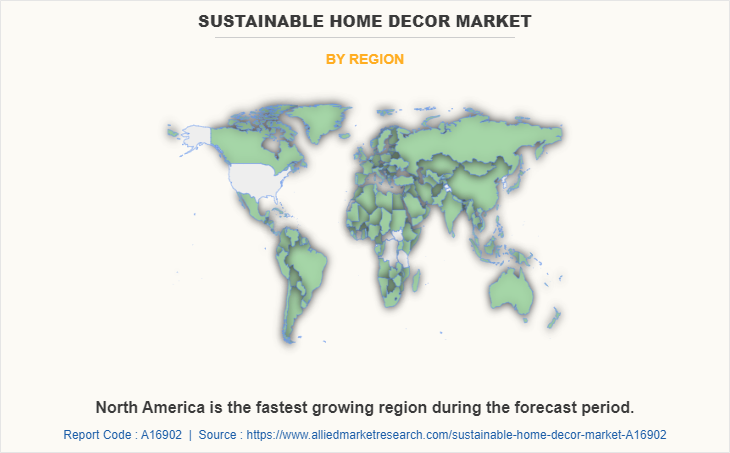
Due to its highly developed retail infrastructure, North America held the global market share for sustainable home decor in 2021. Additionally, intense advertising and celebrity brand endorsements have increased the acceptance of sustainable home decor goods globally, which is boosting the market's expansion. The appeal of sustainable home design items in this region is also boosted by customers spending more on such items and by an improvement in living standards. However, due to the region's rapid infrastructural upgrades in the retail sector and rising consumer disposable income, Asia-Pacific is anticipated to develop at the greatest CAGR during the projected period.
The market is being driven by the increasing use of sustainable materials in furniture manufacture to protect the environment. Additionally, expanding programs like ecologically friendly housing projects in several countries have increased customer interest in eco-friendly furniture. Additionally, the market is anticipated to be driven by the growing number of millennial and generation Z consumers who are purchasing sustainable home decor products.
Due to the abundance of small and medium enterprises, the market for environmentally friendly home decor is quite competitive. A few sustainable strategies include expanding the use of salvaged wood in public and private sector furniture goods and certifications like FTC certification for wooden frames. Businesses are utilizing industry 4.0 technologies to increase manufacturing capabilities. Another aspect that fuels growing competitiveness is the use of e-commerce methods of distribution in high-potential locations.
The market is being driven by the increasing use of sustainable materials in furniture manufacture to protect the environment. Additionally, expanding programs like ecologically friendly housing projects in several countries have increased customer interest in eco-friendly furniture. Additionally, the market is anticipated to be driven by the growing number of millennial and generation Z consumers who are purchasing sustainable home decor products.
Due to the abundance of small and medium enterprises, the market for environmentally friendly home decor is quite competitive. A few sustainable strategies include expanding the use of salvaged wood in public and private sector furniture goods and certifications like FTC certification for wooden frames. Businesses are utilizing industry 4.0 technologies to increase manufacturing capabilities. Another aspect that fuels growing competitiveness is the use of e-commerce methods of distribution in high-potential locations.
The major players analyzed for the sustainable home decor industry are Vermont Woods Studios, Cisco Brothers, Lee Industries Inc., Duresta Upholstery Ltd., Greenington, Jianxgi, La-Z-Boy Inc., Manchester Wooden, Moso International, Shenzhen Vincent Handicraft, Ashley Furniture, Forbo, Herman Miller Inc., Inter IKEA Holding B.V., and Mannington Mills, Inc.
Key Benefits For Stakeholders
- This report provides a quantitative analysis of the market segments, current sustainable home décor market trends, estimations, and dynamics of the sustainable home decor market analysis from 2021 to 2031 to identify the prevailing sustainable home decor market opportunity.
- The market research is offered along with information related to key drivers, restraints, and opportunities.
- Porter's five forces analysis highlights the potency of buyers and suppliers to enable stakeholders make profit-oriented business decisions and strengthen their supplier-buyer network.
- In-depth analysis of the sustainable home decor market segmentation assists to determine the prevailing market opportunities.
- Major countries in each region are mapped according to their revenue contribution to the global market.
- Market player positioning facilitates benchmarking and provides a clear understanding of the present position of the market players.
- The report includes the sustainable home décor market analysis of the regional as well as global sustainable home decor market trends, key players, market segments, application areas, and market growth strategies.
Sustainable Home Decor Market Report Highlights
| Aspects | Details |
| By Product Type |
|
| By Price Point |
|
| By Income Group |
|
| By Distribution Channel |
|
| By Region |
|
| Key Market Players | Kimball International, Mannington Mills Inc., Cisco Bros. Corp., Vermont Woods Studios, Greenington, Forbo International SA, Armstrong World Industries, Inc., Duresta Upholstery Ltd., Ashley Furniture Industries Ltd., La-Z-Boy Inc., Moso International B.V., Inter IKEA Systems BV, Mohawk Industries Inc., Shaw Industries Group, Inc., Herman Miller Inc. |
Analyst Review
According to CXOs of leading companies, due to rising consumer interest in the idea of sustainable house decor, the global market for sustainable home decor is anticipated to rise significantly during the forecast period. Additionally, a rise in urban population and the expansion of the real estate sector in emerging economies have boosted sales of sustainable home decor items, which has fueled the expansion of the global market. Because there is such a huge demand from home buyers, Asia-Pacific is currently the world leader in the home décor industry. Asia-Pacific is predicted to experience a substantial development trend over the projected period due to an increase in demand for sustainable home decor items from nations like China and India. The number of homes and size of households are also anticipated to have an impact on market expansion.
Additionally, it is anticipated that an increase in disposable money and an improvement in personal lifestyles would present lucrative prospects for investors in the market for sustainable home design. Consumers are increasingly accepting eco-friendly, sustainable home design products in the current market. As a result, market participants are concentrating their efforts on creating eco-friendly products in order to take advantage of the rising demand. Competitors in the market compete on factors such product design, style, and raw material quality. In addition, numerous producers are working with importers, builders, and interior designers to market their eco-friendly home furnishings. Additionally, businesses have chosen to use e-commerce platforms to market their goods and boost their profit margins by cutting the cost of distribution.
The global sustainable home décor market size was valued at $331,023.3 million in 2021, and is projected to reach $556,314.9 million by 2031, registering a CAGR of 5.5% from 2022 to 2031.
The forecast period in the sustainable home decor market report is 2022 to 2031.
The base year calculated in the sustainable home decor market report is 2021.
The market value of the sustainable home decor market in 2021 was $331,023.3 million.
The floor covering segment is the most influential segment in the sustainable home decor market report.
The top companies analyzed for global sustainable home decor market report are Vermont Woods Studios, Cisco Brothers, Lee Industries Inc., Duresta Upholstery Ltd., Greenington, Jianxgi, La-Z-Boy Inc., Manchester Wooden, Moso International, Shenzhen Vincent Handicraft, Ashley Furniture, Forbo, Herman Miller Inc., Inter IKEA Holding B.V., and Mannington Mills, Inc.
North America holds the maximum market share of the sustainable home decor market.
The company profile has been selected on the basis of key developments such as partnership, product launch, merger and acquisition.
Loading Table Of Content...



